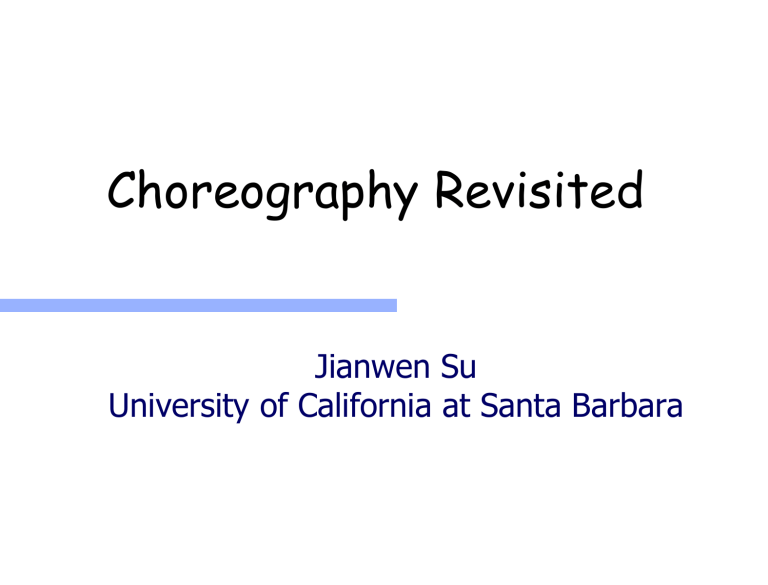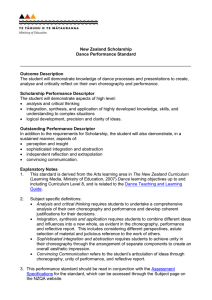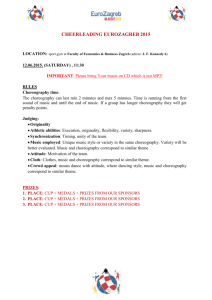Choreography Revisited Jianwen Su University of California at Santa Barbara
advertisement

Choreography Revisited Jianwen Su University of California at Santa Barbara Computing Foundation for Science, Technology, Engineering Modeling & abstraction Algorithmic thinking This talk concerns business processes Retail industry, legal & government, health care, … BPs could be helped by CS in Management of data and processes Techniques for modeling & design, automation Business informatics (as a new sector?) Focus: collaboration between business processes WS-FM '13 2013/08/30 2 Collaboration Models (Extreme Cases) Hub-and-spoke or mediated Orchestration (parallel programming) - performance - failure - security -… Mediator Seller Store Peer global state bottle neck: Warehouse to peer (communicate when needed) Store Bank Bank no bottle neck global state CS can contribute here Seller WS-FM '13 Warehouse 2013/08/30 3 Choreography A choreography defines how biz processes should collaborate to achieve a business goal Store Bank choreography Seller Warehouse Goal: Support for choreography languages: Design “correctness”, auto realization, mechanisms for monitoring, … WS-FM '13 2013/08/30 4 Outline Choreography & biz processes Key Aspects of choreography specification Weaknesses of existing choreography languages Ingredients of our approach Artifacts as biz processes Correlations Message diagrams Snapshots and temporal (choreography) constraints Realization Conclusions WS-FM '13 2013/08/30 5 Examples: Choreographies for Soccer WS-FM '13 2013/08/30 6 Choreographies for BPs Are More Complex usiness Views (for Analytics) WS-FM '13 2013/08/30 7 Correlation of Process Instances A choreography should be aware of process instances not just biz process types Store Bank Seller Seller Seller Warehouse Warehouse Warehouse Existing languages? None support such correlations: WS-CDL, BPMN, process algebras, conversation protocols, Let’s Dance, (BPEL,) … WS-FM '13 2013/08/30 8 Data in Messages and Process Instances Choreography constraints may depend on message contents and data from process instances Store Bank Seller purchase completion is not needed for “small” purchases Seller Seller Seller Warehouse Warehouse Warehouse Most choreography languages support no data, or no general models for data WS-FM '13 2013/08/30 9 What are Needed? Payment Order O1 M1 Purchase P1 P2 P3 F1 Data: if the amount is less 10, then a fulfillment instance can ship even the check is not received F2 Fulfillment Instance-level correlation: Which instances are correlated during the runtime? Who sends messages to whom? WS-FM '13 2013/08/30 10 Existing Choreography Languages Conversation model [Fu et al 2004] Instance correlation Schema correlation Data no yes no WS-CDL no yes message variables* Let’s Dance no yes no 1-to-m only yes message variables* Artifact-centric choreography [Lohmann-Wolf 2010] no yes no Our model yes yes yes [W3C 2005] [Zaha et al 2006] BPEL4Chor [Decker et al 2007] *no clear linkage between variables and processes WS-FM '13 2013/08/30 11 Outline Choreography & Biz Processes Key Aspects of Choreography Specification Weaknesses of existing choreography languages Ingredients of Our Approach Artifacts as Biz Processes who Correlations to whom Message Diagrams sends what at what time Snapshots and Temporal (Choreography) Constraints Realization Conclusions WS-FM '13 2013/08/30 12 Four Types of Data in Biz Processes Essential business data for the process logic: items, shipping addresses, ... Current execution or enactment states: order sent, shipping request made, ... Resource usage and states: cargo space reserved, truck schedule to be determined, ... Correlation between processes instances: 3 warehouse fulfillment process instances for a customer order instance, ... All data should be persistent (maintained properly) Traditional biz process modeling languages are weak in modeling related data WS-FM '13 2013/08/30 13 BP Models: Data Abstraction to Artifacts Four classes of Biz process models: Data agnostic models: data mostly not present WF nets (Petri nets), BPMN, … Data-aware models: data (variables) present, but storage and management hidden BPEL, YAWL, … Storage-aware models: schemas for persistent stores, data mappings to/from BPs defined/managed manually jBPM, … Artifact-centric models: logical modeling for biz data, automated: modeling other 3 types, data-storage mapping GSM, EZ-Flow WS-FM '13 2013/08/30 14 Artifacts As Process Models Should support: instances, process contents, messages Artifact class or interface, data attributes, attribute types may be relational or other artifact classes Store: Order ID CName Addr Bank: Payment ID OrdID Cart INo Seller WHouse Price INo Vendor WHouse Price INo Vendor WHouse Price INo Vendor WHouse INo Vendor WHouse Price Price … Seller: Purchase ID … Warehouse: Fulfillment ID WS-FM '13 … Lifecycle specifications not shown … 2013/08/30 15 Correlation Diagrams Two process instances are correlated if they are involved in a common collaborative BP instance Messaging only between correlated instances Correlations of a CBP are defined in a diagram, with one BP as the root or primary process Order store 1 m Purchase 1 1 Payment bank 1 m seller Fulfillment warehouse Directed edge indicates creation of BP instance(s) Cardinality constraints are also defined Some syntactic restrictions (acyclic, “1” on root, …) WS-FM '13 2013/08/30 16 Referencing Correlated BP Instances Skolem 1 1 Payment notations reference o5 o7 1 1 correlated instances m m Fulfillmento5 is the set of Purchase Fulfillment all Fulfillment instances IDs that are correlated to an Order instance with ID o5 Ordero7 is the Order instance correlated to a Payment instance with ID o7 Path expressions used to access contents of artifact attributes, o5.Cart.Seller denotes all sellers of items in the cart of order o5 WS-FM '13 Order 2013/08/30 17 Derived Correlations A 1 1 Payment Purchase instance and 1 1 a Fulfillment instance is m m correlated if Purchase Fulfillment both correlated to the same Order instance and share at least one item CORRELATE (Purchase, Fulfillment) if OrderPurchase = OrderFulfillment Purchase.Items.INo Fulfillment.Items.INo Order Derived correlations have no cardinality constraints specified, nor instance creation WS-FM '13 2013/08/30 18 “Managing” Correlations Correlations are generated at runtime Some correlations are generated within collaborative BP execution, e.g., creating Fulfillments by Order Some correlations are obtained through external means, e.g., Payment & Order Need to know messaging “patterns” Runtime management of BP instance correlations using Petri nets: [Zhao-Liu CAiSE 07] WS-FM '13 2013/08/30 19 Messages Diagrams InVoice OrderReq+ External OrderComplete PaymentReq+ OrderPayment Order Payment ProcPurchase+ Purchase ReqShipping ProcFulfillment+ PurchaseComplete Fulfillment ShippingComplete A message diagram defines message types and sender/receiver of each type “External” denotes the environment “+” means creation of new BP instance Message may have data attributes Path expressions are used to access data contents WS-FM '13 2013/08/30 20 Outline Choreography & Biz Processes Key Aspects of Choreography Specification Weaknesses of existing choreography languages Ingredients of Our Approach Artifacts as Biz Processes Correlations Message Diagrams Snapshots and Temporal (Choreography) Constraints Realization Conclusions WS-FM '13 2013/08/30 21 System Snapshots (States) system snapshot is a triple (A, M, m) A : a set of “active” artifact instances, M : a set of messages that are already sent, and m : the current message sent Note that data contents are included Also “tracked”: Artifact instance correlations Message-artifact dependencies (a message creates an artifact instance) Message-message dependencies (a message replies to the previous message) A WS-FM '13 2013/08/30 22 Message Predicates and Data Atoms Message predicates: M(m, a, b) M: message type, m message instance ID, a, b: ID of artifact instance (sender, receiver) With a data atom: ProcPurchase(m, a, b) m.cart.price>100 data atoms can involve artifacts (e.g., a, b) Message-message dependencies M[g]: ID of the message of type M in response to g M(M[g], a, b) abbreviated as M[g](a, b) A snapshot formula: a message predicate with one or more data atoms WS-FM '13 2013/08/30 23 Choreography Constraints form: y1 op y2 y1, y2 : snapshot formulas op : binary operators from DecSerFlow: General [van der Aalst et al, 2006] (co-)exists, SUCCession (resp., prec.), etc. (11 kinds) Examples WS-FM '13 2013/08/30 24 Messages Diagram for the Example InVoice OrderReq+ External OrderComplete PaymentReq+ OrderPayment Order Payment ProcPurchase+ Purchase WS-FM '13 ReqShipping ProcFulfillment+ PurchaseComplete Fulfillment ShippingComplete 2013/08/30 25 Choreography Constraints form: y1 op y2 y1, y2 : snapshot formulas op : binary operators from DecSerFlow: General [van der Aalst et al, 2006] (co-)exists, SUCCession (resp., prec.), etc. (11 kinds) An example: OrderReq(m,EXT,x) m.amount>10 SUCC ProcPurchase[m](x,Purchasex) Each order request over 10 should be followed by one (or more) processing purchase messages Free (artifact/message ID) variables are universally quantified WS-FM '13 2013/08/30 26 Another Example xFulfillment yPurchasex PurchaseComplete(m, y, x) y.cart.price>100 SUCC ReqShipping[m](Orderx, x) If there is an item priced >100, shipping request is after all purchasing completion InVoice OrderReq+ External OrderComplete PaymentReq+ OrderPayment Order Payment ProcPurchase+ Purchase WS-FM '13 ReqShipping ProcFulfillment+ PurchaseComplete Fulfillment ShippingComplete 2013/08/30 27 Semantics Based on FO-LTL DecSerFlow operators are expressible in Linear-Time Logic (LTL) Choreography constraints can be translated to firstorder LTL Semantics of FO-LTL is based on sequences of system snapshots WS-FM '13 2013/08/30 28 Outline Choreography & Biz Processes Key Aspects of Choreography Specification Weaknesses of existing choreography languages Ingredients of Our Approach Artifacts as Biz Processes Correlations Message Diagrams Snapshots and Temporal (Choreography) Constraints Realization Conclusions WS-FM '13 2013/08/30 29 Realization Store Bank choreography Seller Warehouse A choreography = a set C of snapshot sequences that satisfy constraints Executable system = a set E of snapshot sequences that may be produced The choreography is realized by the executable system if C = E WS-FM '13 2013/08/30 30 Choreography Decision Problem Problem: Given a choreography, is it realizable? Raised in [Bultan-Fu-Hull-S. WWW 03] Studied in many contexts, especially with process algebras since 2004 [S.-Bultan-Fu-Zhao, WS-FM 07] Crux of the problem: AB: m1 CD: m2 Choreography and A B !m1 ?m1 C !m2 D ?m2 projection to 4 peers When A, B, C, D operate autonomously, m2m1 is possible WS-FM '13 2013/08/30 31 Choreography Realization Problem Given a choreography, how do we design an executable system to realize it? Store Bank choreography Seller Warehouse More practical: Choreography design is a business decision System design is software engineering problem Preliminary result: If a choreography has only 1-1 correlations, it can be realized The executable system uses a small number of auxiliary messages to synchronize WS-FM '13 2013/08/30 32 Outline Choreography & Biz Processes Key Aspects of Choreography Specification Weaknesses of existing choreography languages Ingredients of Our Approach Artifacts as Biz Processes Correlations Message Diagrams Snapshots and Temporal (Choreography) Constraints Realization Conclusions WS-FM '13 2013/08/30 33 Conclusions BPM is a rich research area for CS: modeling, analytics, interoperation, evolution, … Collaborative BPs an interesting & very relevant thread in BPM CS techniques helpful for orchestration CS techniques necesssary for choreography This talk: trying to get to the technical details development of specification languages, realization techniques, runtime monitoring and support, making changes, etc. WS-FM '13 2013/08/30 34 Future Problems Choreography specification with instance and data FO+LTL semantics [Sun 2013] Alternative framework? E.g., FSMs, process algebras, Petri nets, … Analysis of choreography Satisfiability? (Seems undecidable for our language) Finiteness? (Guarantee to terminate in finite steps, likely undecidable) Realization Static compilation Dynamic schemes WS-FM '13 2013/08/30 35

